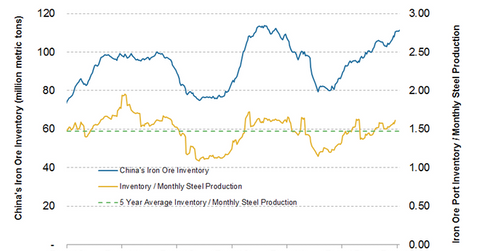What Could Affect Iron Ore Prices in 2017?
Chinese demand is the key driver of iron ore prices, as the country accounts for more than two-thirds of seaborne demand (CLF) (BHP).
Jan. 11 2017, Updated 9:06 a.m. ET

Iron ore prices
Chinese demand is the key driver of iron ore prices, as the country accounts for more than two-thirds of seaborne demand (CLF) (BHP). Most analysts had written off iron ore as being dead long ago. So, why did iron ore prices have a substantial price increase last year? One factor that could explain iron ore’s 2016 price action could be increased Chinese demand.
Chinese imports have been strong
Contrary to what many market participants have suggested, China’s iron ore imports were robust in 2016. For the first 11 months of the year, imports reached 935 million metric tons. They’re set to beat the all-time high of 953 million metric tons of import volumes for 2015.
Notably, Chinese steel demand was better-than-expected in 2016. We saw improvement in the country’s real estate market on the government’s stimulus. China’s car sales also rose sharply in 2016 on the sales tax cut that was announced in late 2015.
As noted previously, higher raw material prices helped steelmakers like U.S. Steel (X), ArcelorMittal (MT), and AK Steel (AKS) raise their base selling prices.
Inventories rise
Meanwhile, China’s iron ore imports have not entirely made it to end users, and we have seen a surge in the country’s iron ore inventories. Iron ore inventories at Chinese ports recently reached a two-year high. Inventories have risen ~20% in 2016. The current inventory level translates to an inventory-to-steel production ratio of 1.6x. The average for this ratio over the last five years is close to 1.5x.
Higher Chinese iron ore inventories could weigh heavily on iron ore prices in 2017. Meanwhile, Chinese demand could also be subdued in 2017, which we’ll explore in detail in the next article.
